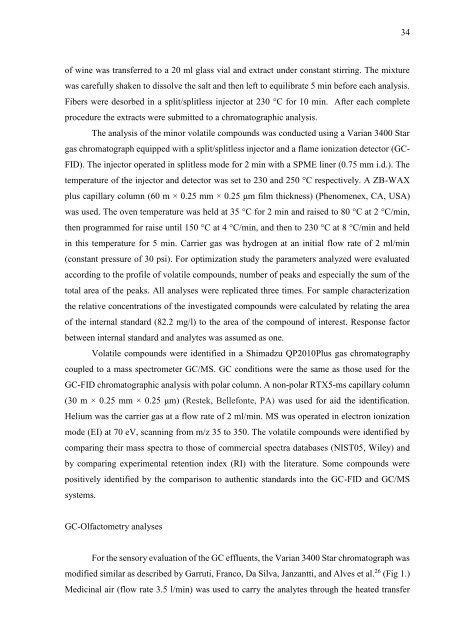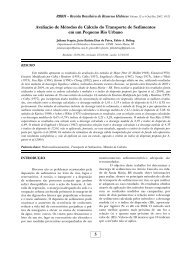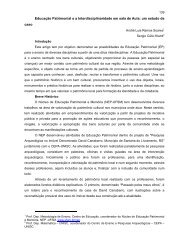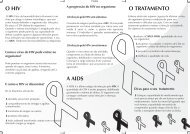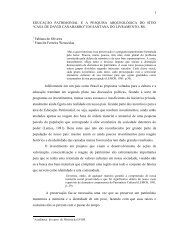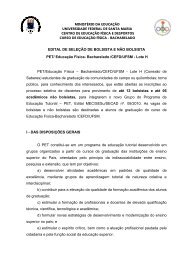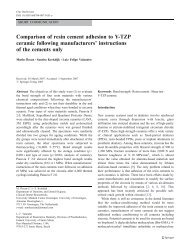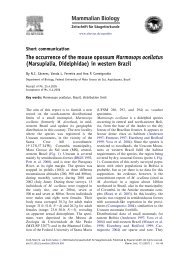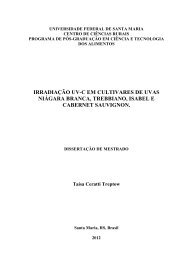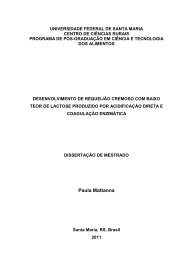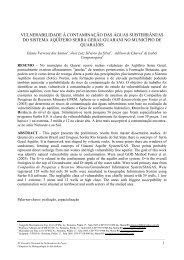DESENVOLVIMENTO E CARACTERIZAÇÃO FÃSICO ... - UFSM
DESENVOLVIMENTO E CARACTERIZAÇÃO FÃSICO ... - UFSM
DESENVOLVIMENTO E CARACTERIZAÇÃO FÃSICO ... - UFSM
Create successful ePaper yourself
Turn your PDF publications into a flip-book with our unique Google optimized e-Paper software.
34<br />
of wine was transferred to a 20 ml glass vial and extract under constant stirring. The mixture<br />
was carefully shaken to dissolve the salt and then left to equilibrate 5 min before each analysis.<br />
Fibers were desorbed in a split/splitless injector at 230 °C for 10 min. After each complete<br />
procedure the extracts were submitted to a chromatographic analysis.<br />
The analysis of the minor volatile compounds was conducted using a Varian 3400 Star<br />
gas chromatograph equipped with a split/splitless injector and a flame ionization detector (GC-<br />
FID). The injector operated in splitless mode for 2 min with a SPME liner (0.75 mm i.d.). The<br />
temperature of the injector and detector was set to 230 and 250 °C respectively. A ZB-WAX<br />
plus capillary column (60 m × 0.25 mm × 0.25 μm film thickness) (Phenomenex, CA, USA)<br />
was used. The oven temperature was held at 35 °C for 2 min and raised to 80 °C at 2 °C/min,<br />
then programmed for raise until 150 °C at 4 °C/min, and then to 230 °C at 8 °C/min and held<br />
in this temperature for 5 min. Carrier gas was hydrogen at an initial flow rate of 2 ml/min<br />
(constant pressure of 30 psi). For optimization study the parameters analyzed were evaluated<br />
according to the profile of volatile compounds, number of peaks and especially the sum of the<br />
total area of the peaks. All analyses were replicated three times. For sample characterization<br />
the relative concentrations of the investigated compounds were calculated by relating the area<br />
of the internal standard (82.2 mg/l) to the area of the compound of interest. Response factor<br />
between internal standard and analytes was assumed as one.<br />
Volatile compounds were identified in a Shimadzu QP2010Plus gas chromatography<br />
coupled to a mass spectrometer GC/MS. GC conditions were the same as those used for the<br />
GC-FID chromatographic analysis with polar column. A non-polar RTX5-ms capillary column<br />
(30 m × 0.25 mm × 0.25 μm) (Restek, Bellefonte, PA) was used for aid the identification.<br />
Helium was the carrier gas at a flow rate of 2 ml/min. MS was operated in electron ionization<br />
mode (EI) at 70 eV, scanning from m/z 35 to 350. The volatile compounds were identified by<br />
comparing their mass spectra to those of commercial spectra databases (NIST05, Wiley) and<br />
by comparing experimental retention index (RI) with the literature. Some compounds were<br />
positively identified by the comparison to authentic standards into the GC-FID and GC/MS<br />
systems.<br />
GC-Olfactometry analyses<br />
For the sensory evaluation of the GC effluents, the Varian 3400 Star chromatograph was<br />
modified similar as described by Garruti, Franco, Da Silva, Janzantti, and Alves et al. 26 (Fig 1.)<br />
Medicinal air (flow rate 3.5 l/min) was used to carry the analytes through the heated transfer


